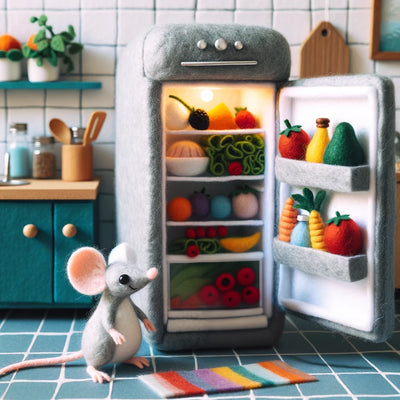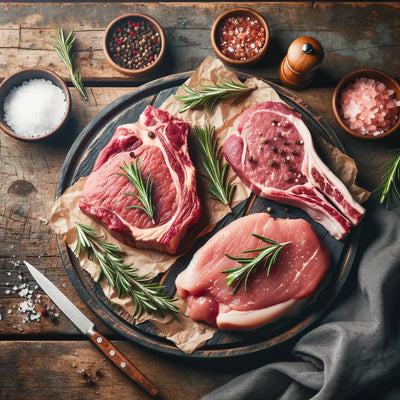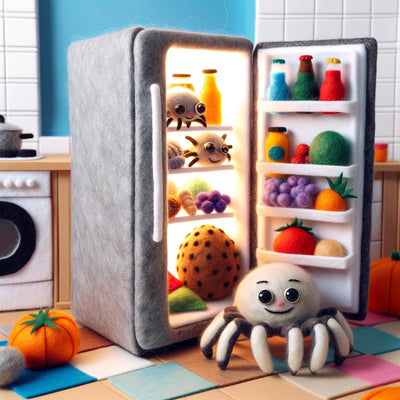Importance of Proper Food Storage
Why Properly Storing Cooked Chicken is Essential
Proper food storage is vital to maintaining the freshness and safety of your meals, especially when it comes to cooked chicken. It is a perishable food item that, when stored correctly, can prolong its shelf life and preserve its quality. Proper storage helps in slowing down the growth of bacteria, ensuring that your leftovers remain safe to consume and reducing food waste.
When you transfer your cooked chicken from plate to fridge safely, you are taking a critical step in food preservation. Correctly stored cooked chicken can be a convenient and delicious part of future meals, whether it's for a quick lunch or as part of a larger dinner spread. It's crucial to understand the guidelines for refrigeration and freezer storage to maximize the longevity of your chicken's freshness.
Risks of Improper Storage
Improper storage of cooked chicken can lead to several risks, including foodborne illness. Bacteria such as Salmonella and Campylobacter can thrive on chicken that is not refrigerated promptly and at the right temperature. Symptoms of food poisoning can range from mild discomfort to severe health complications, particularly in young children, the elderly, and those with compromised immune systems.
Here are some risks associated with improper storage:
- Growth of bacteria: Bacteria can double in number in as little as 20 minutes at room temperature.
- Loss of taste and texture: Cooked chicken may become dry or develop off-flavors.
- Food waste: Chicken that has gone bad due to improper storage must be discarded.
To mitigate these risks, ensure you follow the fridge mastery guidelines for the shelf life of cooked chicken and maintain your refrigerator at the ideal temperature for storing cooked chicken. Additionally, familiarize yourself with the principles of safe food handling to avoid cross-contamination and other safety hazards.
Learning how to properly store cooked chicken from plate to fridge not only ensures longer freshness but also contributes to a more sustainable and health-conscious kitchen routine.
Transitioning from Plate to Fridge
Ensuring your cooked chicken remains fresh and safe to consume involves more than just placing it in the refrigerator. The transition from plate to fridge is a critical process that needs careful consideration.
Cooling Down Cooked Chicken
After you've enjoyed a meal, it's important to cool down the cooked chicken before refrigerating it. Chicken should not be left out at room temperature for more than two hours, or one hour if the temperature is above 90°F. This is to prevent bacterial growth that can occur in the "danger zone" between 40°F and 140°F.
Here's how you can cool down cooked chicken properly:
- Divide larger portions into smaller ones to allow for quicker cooling.
- Place the chicken in shallow containers to expedite the cooling process.
- Keep the chicken uncovered in the refrigerator until it has completely cooled. This prevents heat from being trapped which could increase the risk of bacteria growth.
Once the chicken is cooled, it should reach an internal temperature of 40°F or less, which is the safe temperature for refrigerated storage.
Best Practices for Transferring to the Fridge
To maintain the quality and safety of your cooked chicken, consider the following best practices when transferring it to the fridge:
- Use airtight containers or resealable plastic bags to prevent air exposure and moisture loss.
- Label the storage containers with the date to track how long the chicken has been stored.
- Place the chicken in the refrigerator promptly after it has cooled to minimize the time it spends in the danger zone.
By following these guidelines, you ensure that your cooked chicken retains its freshness and is safe for later consumption. For more information on refrigerator storage and to find the ideal appliance that fits your needs, you may explore articles such as unlock the perfect pour exploring different kegerator sizes or upgrade your cooling game best 30 bottom freezer refrigerators for you.
Adhering to proper food storage practices from plate to fridge is not only about preserving the taste and quality of your chicken but also about ensuring the health and safety of you and your family. For further details on the shelf life of cooked chicken in the fridge, visit our detailed guide at fridge mastery knowing the exact shelf life of cooked chicken.
Refrigerator Storage Guidelines
Storing your cooked chicken properly in the refrigerator is critical to maintaining freshness and ensuring safety. Let's cover the optimal conditions for refrigeration and how to best position your cooked poultry.
Ideal Temperature for Storing Cooked Chicken
The refrigerator should be set at a temperature that inhibits bacterial growth while keeping your cooked chicken fresh. The USDA recommends:
| Storage Location | Temperature |
|---|---|
| Refrigerator | 40°F (4°C) or below |
Ensure your refrigerator is at the ideal temperature by regularly monitoring with an appliance thermometer. This simple step can make a significant difference in the longevity of your cooked chicken's freshness. For more detailed guidelines on safe food storage temperatures, check out our article on the art of preservation: finding the right chill for your fridge.
Proper Placement in the Fridge
Where you place your cooked chicken in the refrigerator can impact its shelf life. To avoid cross-contamination and to maintain quality, follow these tips:
- Upper Shelves: Store cooked chicken on the upper shelves of your refrigerator, away from raw foods. This helps prevent any raw juices from contaminating your cooked food.
- Sealed Containers: Use airtight containers or resealable plastic bags to keep your chicken from absorbing other flavors and aromas in the fridge.
- Away from the Door: The refrigerator door is the warmest part, so keep your cooked chicken away from this area to ensure a consistent temperature.
For insights into organizing your refrigerator more efficiently, including cooked chicken storage, take a look at how to organize french door refrigerator.
Following these storage guidelines will help keep your cooked chicken safe and delicious for as long as possible. Remember, when in doubt, always err on the side of caution with food safety to prevent any risks associated with improperly stored poultry. For further information on how long you can keep cooked chicken in the fridge, visit fridge mastery: knowing the exact shelf life of cooked chicken.
Freezer Storage Tips
Properly freezing cooked chicken is an effective way to extend its freshness and ensure it's safe for future consumption. Here, you'll find tips for freezing cooked chicken and guidelines for optimal freezer storage.
Freezing Cooked Chicken for Extended Freshness
Freezing cooked chicken can preserve its quality for several months. To maximize freshness, it's important to freeze the chicken as soon as it cools to room temperature. Ideally, you should not leave cooked chicken at room temperature for more than 2 hours to prevent bacterial growth.
When preparing chicken for freezing:
- Divide large portions into smaller, meal-sized quantities. This aids in quick and even freezing and later facilitates easier thawing.
- Remove as much air as possible from freezer bags or containers to prevent freezer burn.
- Flatten the contents in the bag to distribute the chicken evenly, which also helps with space-saving storage.
Packaging and Labeling for Freezer Storage
Selecting the right packaging materials is crucial to protect the chicken from air exposure and freezer burn. Suitable packaging options include:
- Freezer-safe bags
- Airtight containers
- Heavy-duty aluminum foil
- Freezer wrap
When packaging cooked chicken, ensure it's wrapped tightly and securely to prevent any air from entering. Once the chicken is packaged, label each container or bag with the contents and the date of freezing. This will help you keep track of how long the chicken has been stored and use it within the recommended timeframe.
| Item | Duration |
|---|---|
| Cooked Chicken Pieces | 4-6 months |
| Whole Cooked Chicken | 4 months |
| Chicken Broth or Gravy | 2-3 months |
For detailed guidelines on the recommended storage duration for different types of cooked chicken, refer to our comprehensive resource on fridge mastery knowing the exact shelf life of cooked chicken.
Remember, when you're ready to use your frozen chicken, thaw it safely in the refrigerator or by using a microwave's defrost setting. Avoid thawing chicken at room temperature to reduce the risk of bacterial growth. Once thawed, the chicken should be consumed within 24 hours for the best quality and safety.
By following these freezer storage tips, you can enjoy your cooked chicken at a later date without compromising on taste or safety. Whether you're storing a full meal or leftover pieces, proper freezing techniques are essential in extending the shelf life of your chicken. For more storage solutions, explore our selection of top freezer refrigerators that can help keep your food organized and fresh.
Safety Precautions
Ensuring the safety of your food is paramount when storing cooked chicken, which requires diligence to prevent foodborne illnesses. By following the correct safety precautions, you can enjoy your meals with peace of mind.
Avoiding Cross-Contamination
Cross-contamination can occur when bacteria from raw food, such as uncooked poultry, meats, or fish, are transferred to cooked food or foods that will be eaten raw, like salads. To avoid this:
- Always use separate cutting boards for raw and cooked foods. Consider color-coded boards to keep them distinct.
- Ensure that utensils and plates used for raw chicken are thoroughly washed before being used for other foods.
- Wash your hands with soap and water for at least 20 seconds after handling raw chicken and before touching other foods or surfaces.
- Do not place cooked chicken back on the same plate or surface that held it raw without proper cleaning.
For more information on organizing your refrigerator to prevent cross-contamination, you might be interested in reading how to organize french door refrigerator.
Handling Leftovers Safely
Leftovers can be a great way to enjoy your meals for longer, but they must be handled correctly:
- Cool cooked chicken at room temperature for no longer than two hours before refrigerating.
- Store leftovers in shallow containers to allow for quicker cooling in the refrigerator.
- Label your containers with the date of storage. Cooked chicken should be consumed within 3 to 4 days when refrigerated.
- When reheating, ensure that the chicken reaches an internal temperature of 165°F (74°C) to eliminate any potential bacteria.
| Action | Time/Temp |
|---|---|
| Cooling Time | Max 2 hours at room temp |
| Refrigerator Storage | 3-4 days |
| Reheating Temperature | 165°F (74°C) |
For more details on the shelf life of cooked chicken and how to maximize its freshness, visit fridge mastery knowing the exact shelf life of cooked chicken.
Remember, these safety precautions are not only crucial for maintaining your health but also for preserving the flavor and quality of your stored cooked chicken. By implementing these practices, 'from plate to fridge safely storing cooked chicken for longer freshness' becomes a seamless and worry-free process.
Reheating Cooked Chicken
Properly reheating stored cooked chicken is not just about warming it up; it's about ensuring the chicken is safe to eat and still delicious. The process should be handled with care to avoid any foodborne illnesses and to preserve the chicken's quality.
Safely Reheating Stored Chicken
When you reheat cooked chicken, aim for an internal temperature of 165°F to eliminate any potential bacterial growth. Use a food thermometer to check the temperature at the thickest part of the chicken. Here are the steps to safely reheat your chicken:
- Preheat your oven, stovetop, or microwave.
- Place the chicken in a heat-safe container if it's not already in one.
- Cover the chicken with a lid or aluminum foil to retain moisture.
- Reheat until the chicken reaches the recommended internal temperature.
| Method | Temperature | Time |
|---|---|---|
| Oven | 350°F | 10-15 min |
| Stovetop | Medium Heat | 5-10 min |
| Microwave | High | 1-3 min |
Remember, if you're reheating chicken in a microwave, the time may vary depending on the wattage, and it's advisable to rotate or stir the chicken halfway through for even heating. For more guidance on reheating and food safety, you may want to read about fridge mastery knowing the exact shelf life of cooked chicken.
Tips for Maintaining Flavor and Texture
To maintain the flavor and texture of your chicken when reheating, consider these tips:
- Add a few tablespoons of chicken broth or water to the chicken before reheating to prevent drying out.
- If using an oven, reheat at a lower temperature for a longer period to avoid toughness.
- For crispy skin, finish reheating in the oven on broil for the last few minutes.
- Avoid overheating as it can lead to dry and rubbery chicken.
Maintaining the succulence and taste of your cooked chicken is vital, whether it's been stored in the fridge or freezer. If you're interested in other preservation methods, you might find keeping it fresh how long can pasta stay refrigerated helpful. By following these reheating techniques, you ensure that your meal is both safe to consume and enjoyable, just like when it was freshly cooked.
Get Your Upgrade or New Addition at Fridge.com
Whether you're searching for your perfect fridge, freezer, wine fridge, beer fridge, ice maker, or kegerator, we have what you need.
Shop the world's best brands at Fridge.com.
We also have tons of awesome articles about kitchen stuff and home news. Enhance your home, garage, backyard, patio, and office with the coolest essentials. With every necessary type of residential refrigerator or freezer in our collection, we've got you covered.
Elevate your game and shop now at Fridge.com!






